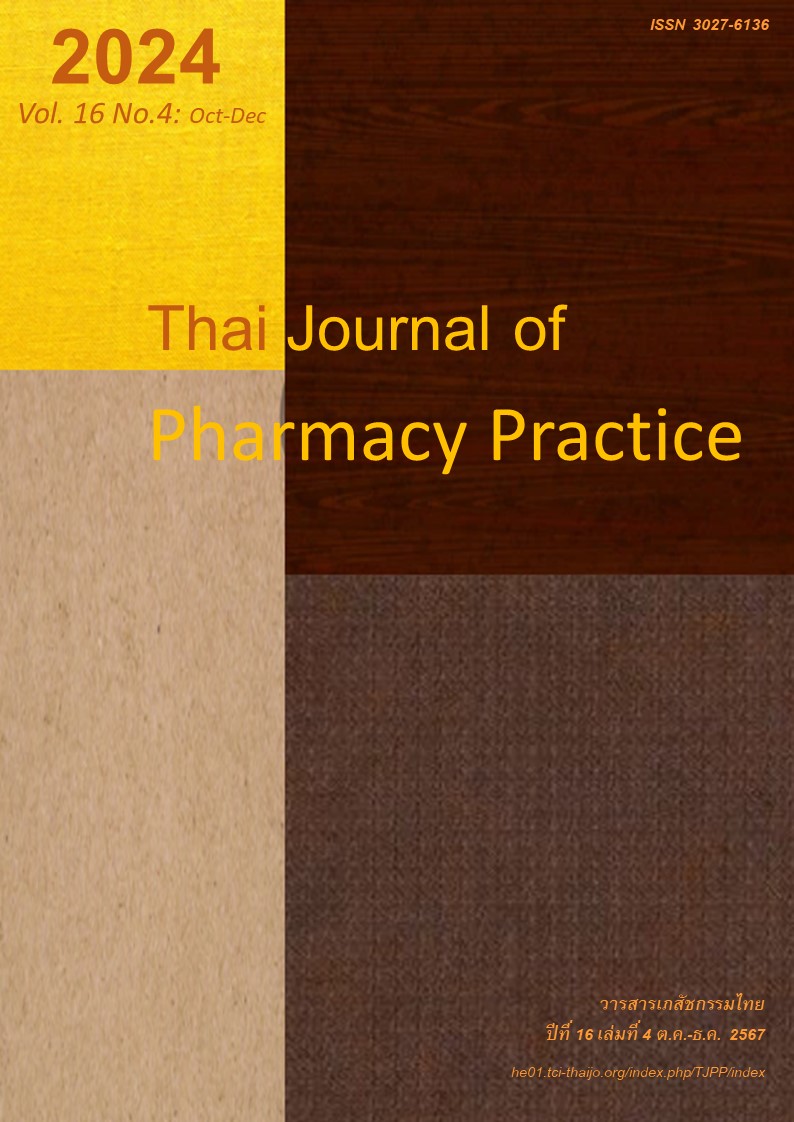การพัฒนาแบบประเมินความแตกฉานด้านสุขภาพสำหรับชาวไทยฉบับสั้น: การประยุกต์ใช้ทฤษฎีการตอบสนองข้อสอบ
Main Article Content
บทคัดย่อ
วัตถุประสงค์: เพื่อพัฒนาและตรวจสอบคุณภาพแบบวัดฉบับสั้นของแบบประเมินความแตกฉานด้านสุขภาพ ชนิดรายการคำที่มีคำถามทดสอบความเข้าใจสำหรับชาวไทย (short version of the Thai Health Literacy Assessment Using Word List with Extended Questions to Test Comprehension: STHLA-W+) โดยใช้ทฤษฎีการตอบสนองข้อสอบ (Item Response Theory: IRT) วิธีการ: การศึกษาวิเคราะห์ข้อมูลจากงานวิจัยในอดีตซึ่งใช้ THLA-W+ ในการสำรวจระดับความแตกฉานด้านสุขภาพ (health literacy: HL) ของประชาชน 7 จังหวัดภาคใต้จำนวน 1,310 คน เพื่อพิจารณาเลือกข้อคำถามจากค่าพารามิเตอร์ของข้อคำถามรายข้อตามหลักการของ IRT จากนั้นทดสอบความตรง ความเที่ยง และหาเกณฑ์คะแนนเพื่อใช้แปลผลระดับ HL ของ STHLA-W+ ในตัวอย่างกลุ่มใหม่ คือ ประชาชนจังหวัดยะลาจำนวน 200 คน ผลการวิจัย: ข้อคำถามทั้ง 48 ข้อผ่านเกณฑ์สมมติฐานเบื้องต้นของ IRT และมีความสอดคล้องกับ two-parameter logistic model การเลือกข้อคำถามตามเกณฑ์ค่าอำนาจจำแนก (a) ค่าความยาก (b) และตัดข้อคำถามที่มีการทำหน้าที่ต่างกัน (differential item functioning; DIF) จากอิทธิพลของวุฒิการศึกษาและอายุ ทำให้ได้แบบวัดฉบับสั้นที่มีข้อคำถามจำนวน 19 ข้อ การทดสอบ STHLA-W+ ในตัวอย่างกลุ่มใหม่พบว่า แบบวัดมีความเที่ยงที่ดี (Cronbach’s alpha = 0.808) มีความตรงโดยค่าสัมประสิทธิ์สหสัมพันธ์ระหว่างคะแนน STHLA-W+ กับตัวชี้วัด HL ชนิดอื่นมีความสัมพันธ์ในทางบวกอยู่ในช่วง 0.20 – 0.37 และผู้ที่มีวุฒิการศึกษาสูงกว่ามีคะแนน STHLA-W+ ที่สูงกว่า แบบวัดมีความสามารถปานกลางในการจำแนกผู้ที่มี HL ที่เพียงพอและไม่เพียงพอ (AUC = 0.67 – 0.73) จุดตัดคะแนนของ STHLA-W+ คือ 16 คะแนน นั่นคือผู้ที่ได้คะแนนน้อยกว่าหรือเท่ากับ 16 คะแนนจาก 19 คะแนนมี HL ที่ไม่เพียงพอ สรุป: การใช้ IRT พัฒนาแบบวัดฉบับสั้นทำให้ได้แบบวัดที่มีจำนวนข้อคำถามร้อยละ 40 เมื่อเทียบกับแบบวัดฉบับเดิม แบบวัดใช้เวลาทดสอบเฉลี่ยไม่เกิน 4 นาที และสามารถใช้ประเมิน HL เบื้องต้นในประชาชน
Article Details

อนุญาตภายใต้เงื่อนไข Creative Commons Attribution-NonCommercial-NoDerivatives 4.0 International License.
ผลการวิจัยและความคิดเห็นที่ปรากฏในบทความถือเป็นความคิดเห็นและอยู่ในความรับผิดชอบของผู้นิพนธ์ มิใช่ความเห็นหรือความรับผิดชอบของกองบรรณาธิการ หรือคณะเภสัชศาสตร์ มหาวิทยาลัยสงขลานครินทร์ ทั้งนี้ไม่รวมความผิดพลาดอันเกิดจากการพิมพ์ บทความที่ได้รับการเผยแพร่โดยวารสารเภสัชกรรมไทยถือเป็นสิทธิ์ของวารสารฯ
เอกสารอ้างอิง
Sørensen K, den Broucke SV, Fullam J, Doyle G, Pelikan J, Slonska Z, et al. Health literacy and public health: A systematic review and integration of definitions and models. BMC Public Health 2012; 25: 12:80.
Berkman ND, Sheridan SL, Donahue KE, Halpern DJ, Crotty K. Low health literacy and health outcomes: an updated systematic review. Ann Intern Med. 2011; 155: 97-107.
Kaeodumkoeng K. Health Literacy: access, under- stand and application. Bangkok: Amarin books, 2018.
Chanchuto P. Development of the Thai Health Literacy Assessment Using Word List with Extended Questions to Test Comprehension (THLA-W+): testing in Sadao Hospital [master thesis]. Songkhla: Prince of Songkla University; 2017.
Lee SY, Bender DE, Ruiz RE, Cho YI. Development of an easy-to-use Spanish Health Literacy test. Health Serv Res 2006; 41:1392-412.
Phantong W. Development of the Thai Health Literacy Assessment using Word List (THLA-W). [master thesis]. Songkla: Prince of Songkla University; 2016
Daraman N. Validation of the Thai Health Literacy Assessment Using Word List with Extended Questions to Test Comprehension in Muslim Patients [master thesis]. Songkhla: Prince of Songkla University; 2018.
Hayibueraheng H. Development of the Thai Health Literacy Assessment Using Word List with Extended Questions to Test Comprehension (THLA -W+): Testing in community [master thesis]. Songkhla: Prince of Songkla University; 2018.
Wongsatapornpat W. Health literacy survey in Thais residing in the lower south [master thesis]. Songkhla: Prince of Songkla University; 2019.
Kanjanawasee S. Classical test theories. Bangkok: Chulalongkorn University Printing House; 2013.
Nils P, Dirk H, Matthias B. A new method for estimating the variance overlap between the shot and the long form of a psychological test. Educ Psychol Meas 2011; 71: 380-8.
Woods CM, Thissen D. Item response theory with estimation of the latent population distribution using spline-based densities. Psychometrika 2006; 71: 281–301.
Hambleton RK, Swaminathan H, and Rogers H. Fundamentals of item response theory. Newbury Park, CA: Sage; 1991.
Kerlinger FN. Foundations of behavioral research. 3rd ed. New York: Holt, Rinehart and Winston; 1986.
Vanitchbancha K. Advanced statistical analysis with SPSS for Windows. 8th ed. Bangkok: Thammasarn; 2010.
Reckase MD. Unifactor latent trait models applied to multifactor tests: Results and implications. J Educ Stat 1979; 4: 207-30.
Hambleton RK, Swaminathan H. Item response theory: Principles and application. Boston: Khewer-Nijhoff Publishing; 1985.
Kanjanawasee S. Modern test theories. 5th ed. Bangkok: Chulalongkorn University Printing House; 2020.
R Core Team. A language and environment for statistical computing [online]. 2021 [cited Jun 8, 2022]. Available from: www.R-project.org
Kang T, Cohen AS. IRT model selection methods for dichotomous items. Appl Psychol Meas 2007; 31: 331–58.
Rizopoulos D. Package ‘ltm’. R package version 1.1–0 [online]. 2012 [cited Jun 8, 2022]. Available from: cran.r-project.org/web/packages/ltm/index.html
Magis D, Beland S, Tuerlinckx F, et al. A general framework and an R package for the detection of dichotomous differential item functioning. Behav Res Methods 2010; 42: 847–62.
Urry VW. Tailored Testing: A successful application of latent trait theory. J Educ Meas 1977; 14: 181-96.
Cronbach LJ, Meehl PC. Construct validity in psycho logical tests. Psychol Bull 1955; 52, 281-302.
Faul GF, et al. Statistical power analyses using G*Power 3.1: Tests for correlation and regression analyses. Behav Res Methods 2009; 41: 1149-60.
Chew L, Griffin JM, Partin MR, Noorbaloochi S, Grill JP, Snyder A, et al. Validation of screening questions for limited health literacy in a large VA outpatient population. J Gen Intern Med 2008; 23: 561-6
Parker RM, Baker DW, Williams MV, Nurss JR. The test of functional health literacy in adults: a new instrument for measuring patients’ literacy skills. J Gen Intern Med 1995; 10: 537 -41.
Jindawong B. Validity and reliability of the Thai version of health literacy screening tools for patients at Srinagarind Hospital, Khon Kaen, Thailand. [master thesis]. Khon Kaen: Khon Kaen University; 2013.
Swets JA. Measuring the accuracy of diagnostic systems. Science 1988; 240:1285-93.
Pornprasit T. Psychometric Properties and Cut-offs of the Thai Health Literacy Assessment Using Word List with Extended Questions to Test Comprehen- sion (THLA-W+) [master thesis]. Songkhla: Prince of Songkla University; 2019.
Pfeiffer N, Hagemann D, Backenstrass M. A new method for estimating the variance overlap between the short and the long form of a psychological test. Educ Psychol Meas 2011; 71: 380–8.
Gazmararian JA, Baker DW, Williams MV, Parker RM, Scott TL, Green DC, et al. Health literacy among Medicare enrollees in a managed care organization. JAMA 1999; 10: 545-51.
Kutner M, Greenberg E, Jin Y et al. The health literacy of America’s adults: results from the 2003 National Assessment of Adult Literacy [online]. 2006 [cited Jun 21, 2021] Available from: nces.ed.gov/ pubs2006/2006483.pdf


